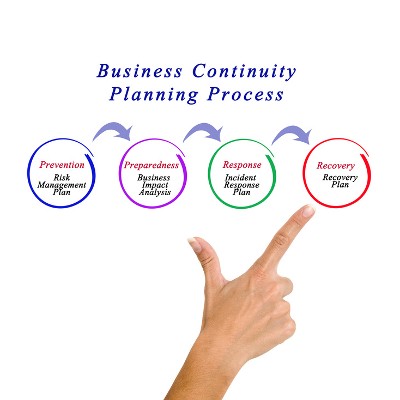Does your organization have an internal IT department? If so, you’ve probably noticed that they are too busy problem solving to focus on improving your infrastructure. If they do have time to innovate, chances are they’re neglecting important maintenance. All it takes to improving your infrastructure and operations is, contacting your local managed service provider.
Computerware Blog
Data backup is something of a conundrum for many small businesses. The classic mindset is that they don’t think they need data backup because there’s no way they’ll be struck with a data loss disaster. Their office may not be located in a place prone to natural disasters, and the organization is so small that the assume they are off the hook when it comes to hackers. This doesn’t reduce the value that a good data backup system can offer, though.
Procuring equipment is a necessary part of managing any business, but this is often easier said than done. Your organization works with multiple vendors, which could be both confusing and time-consuming. How does your business manage its vendors, and is there a way to make this easier and more efficient?
The business world increasingly relies on IT services. Regardless of which industry you fall into, IT will undoubtedly play a major role in how your business functions on a daily basis. Businesses also need their technology to remain in proper working order, but this is easier said than done--especially if you don’t have the luxury of an in-house IT department. Thankfully, managed service providers make this much less difficult.
Your business’s IT strategy is of incredible importance, especially when you consider how much your operations stand to benefit from a functional infrastructure. More than anything, though, IT can ensure that your business remains competitive in a world where the slightest advantage can mean all the difference.
Smart business owners always look for ways to improve the way their organization functions. Digital transformation is one of these ways, as it allows for organizations to use technology to minimize waste and enhance workflow. To help you with digital transformation, we’ll walk you through what it is and how it works.
A business without its own IT department will expend vast amounts of time and resources to manage its technology. Tasks like managing your email solution, upgrading or managing your desktop infrastructure, or securing your network from threats, can be draining. If you don’t have time to perform these tasks, then it’s worth it to invest in an outsourced IT provider for your technology needs.
Customer service can be tricky to gauge sometimes, as you don’t often hear about a consumer’s experience unless you provide exceptional service, or if you’re not providing good enough service. The problem here is that, unless you do something to improve the customer service you provide, you could very well lose them to your competition. What are some steps that your business can take to improve customer service?
It’s a nightmare situation for any business owner when all of their essential data suddenly disappears. Fortunately, there are measures that you can take to turn this nightmare into an inconvenience. However, you must also be certain that these measures are adequate to keep your data safe, despite the worst of circumstances.
Remember, there is a difference between a “disaster” and a “data disaster,” although the two are often connected in a cause-and-effect kind of way. A disaster is some event that puts a business in peril, oftentimes leading to a data disaster, where some large degree of data loss is experienced.
Keep in mind, a data disaster doesn't rely on a “typical” disaster in order to take place. Hardware failure, user error, and hacking attacks can all contribute to a data disaster.
Either way, nothing about any type of disaster is easily manageable. Either can have serious repercussions for your business if you don’t have a backup solution preemptively in place. However, this backup solution should meet certain criteria:
- Backups should be taken multiple times a day, ideally as often as every 15 minutes.
- It must be stored in multiple offsite locations. This will help keep your backup from being destroyed by the same disaster that took your original data.
- It must be tested on a regular basis to make sure it works. Otherwise, you may as well not have one in the first place.
Keep in mind, maintaining a backup solution is only half of the business continuity battle. Preserving your data is important, but should a true disaster endanger your business, you’ll need a comprehensive Backup and Disaster Recovery plan.
To ensure your business continuity, Computerware can help you create a data backup plan. Give us a call at (703) 821-8200 to get started.
It’s not unheard of for organizations to experience immense technological trouble that brings future potential problems into question. Surprises like these can spell trouble for businesses that are unprepared, especially considering the major damage it could cause to your budget. This forces you to ask yourself if you know what your current plan for IT covers, and what you want your provider to do to eliminate unexpected billing surprises.
Despite cash having been king for centuries, many businesses today have elected to implement cashless payment options as their customers increasingly rely on the mobile payment technologies that their personal devices allow. These businesses are the ones making the smart choice, as there are many factors that encourage the adoption of alternative payment technologies.
Business owners have a lot to worry about. However, keeping workstations, server units, mobile devices, and various software solutions in good working order doesn’t have to be a concern--that is, if you outsource these responsibilities to the right IT professionals.
As a business owner, how do you handle employee complacency? A feeling of complacency among your employees can come from many sources, including an apparent inability of advancement. People want to develop professionally, so they’ll look elsewhere if they feel like their current job doesn’t allow for growth. How can you eliminate employee turnover due to a complacent and unchallenged workforce?
Does your business understand the importance of having a long-term IT budget? Your organization needs to be privy to the latest technology trends, which can change drastically depending on the year’s developments. Does your budget take into account the current value (or lack thereof) of your organization’s technology assets? Do you think about where you want to be in the future? If this sounds like too much to handle, the consulting service of an IT professional will provide you with an accurate plan.
If there’s one concept that every business owner needs to be intimately familiar with, it’s business continuity. Boiled down, the concept tackles the question of how your business will carry on after a disaster situation has struck. While a business continuity plan is by no means a simplistic document, there are a few key points that all businesses should focus on.
Is your business prepared to deal with network downtime? By this, we mean any situation when your organization’s network infrastructure isn’t operating as intended. Maybe you’ve lost power in your office, or you’ve experienced a data loss incident that keeps you from accessing crucial information. To prepare your SMB for times like this, you need to ask if your organization can handle such a wasteful occurrence.
Collaboration can present a great many benefits for the modern business. With technological innovations making it simpler than ever to cooperate, today’s business owners and executives need to know how to leverage these technologies into greater organizational efficiency. For this week’s tip, we give you five points of emphasis every manager has to understand in order to make new collaborative technology work for your business.
Like it or not, millennials will make up a large part of your workforce in the near future. In your own business, you may have noticed quite the difference in the way that millennials approach work compared to other members of your staff. One of the biggest differences that you might have noticed is that millennials have no problem job-hopping. According to a recent study, one of the biggest reasons why millennials leave a company is due to outdated technology.



















